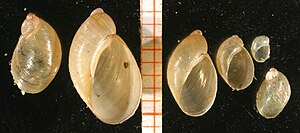Reddish amber snail
| Reddish amber snail | ||||||||||||
|---|---|---|---|---|---|---|---|---|---|---|---|---|

Reddish amber snail ( Oxyloma sarsii ) |
||||||||||||
| Systematics | ||||||||||||
|
||||||||||||
| Scientific name | ||||||||||||
| Oxyloma sarsii | ||||||||||||
| ( Esmark , 1886) |
The reddish amber snail ( Oxyloma sarsii ) is a species of snail belonging to the amber snail family (Succineidae) from the suborder of land snails (Stylommatophora).
features
The case is 12 to 15 mm, exceptionally up to 20 mm high and 6 to 9 mm wide. The housing of the living animal appears dark gray to black due to the dark soft body. The empty case is amber and translucent. It has three rapidly increasing turns. The skin is thin, the surface is shiny with coarse, somewhat irregular growth strips. The seam is distinct and relatively deep. The mouth is narrowly egg-shaped with a pointed upper end. The lower edge of the mouth is often only slightly curved; this makes the mouth appear slightly triangular. The mouth rim itself is thin and only slightly thickened on the outside.
The soft body has dense, star-shaped, jagged pigment spots, making it appear very dark to almost black. The sole is pale, almost translucent.
In the genital system, the penis is relatively long with a swelling at the apex and an inner, rolled up epiphallus . He is completely surrounded by a penis sleeve. There are irregular longitudinal folds inside the penis. The spermatic duct penetrates the penis at the apex. The penile retractor muscle also attaches to the apex of the penis. The vagina is very long and becomes very narrow towards the base of the seminal vesicle, the stem of the rounded seminal vesicle is very far from the entrance of the vagina. The fallopian tube is comparatively short, the slender stem of the seminal vesicle is also comparatively short.
Similar species
The shell resembles that of the closely related slender amber snail ( Oxyloma elegans ); the two types cannot be reliably differentiated from the housing. It is usually slightly larger and slimmer than that of the slender amber snail. The sideline is flatter. In the reproductive system of the reddish amber snail, the penis is slightly longer and the vagina is much longer. In the slender amber snail, the vagina is very short and wide, the stem of the seminal vesicle is only a short distance from the entrance of the vagina. The slender stem of this species is significantly longer than that of the reddish amber snail.
Geographical distribution and habitat
The distribution area of the reddish amber snail is poorly known because of the frequent confusion with the slender amber snail in older literature. It stretches from Ireland, southern England through Scandinavia to northern Siberia (Yakutia). In Central Europe there is evidence from Denmark, the Netherlands, Belgium, Germany, Austria and possibly also from Northern Italy. Otherwise it is absent in Western and Southern Europe. But it "probably" occurs in Bulgaria too. Evidence of Oxyloma pfeifferi (a synonym of Oxyloma sarsii ) in northwest Africa would need to be verified.
It lives on the edges of moors, swamps, lakes and slowly flowing rivers and streams with little vegetation, especially on floodplains. Here it follows the waterline and is never far from standing water. In this habitat it crawls around on aquatic plants, especially on swaths ( Glyceria ) and floating aquatic plants.
Taxonomy
The taxon was established in 1886 by Birgithe Esmark as a variety of Succinea pfeifferi Rossmässler, 1835. The original spelling is sarsii , which cannot be corrected due to the rules of zoological nomenclature. Nevertheless, the spelling sarsi can often be found in the literature. Succinea pfeifferi is a synonym of Oxyloma elegans (Risso, 1826) (slender amber snail).
Danger
According to Vollrath Wiese, the data situation is insufficient to correctly assess the endangerment of the species.
supporting documents
literature
- Rosina Fechter, Gerhard Falkner: Mollusks (= Steinbach's natural guide. 10). Mosaik-Verlag, Munich 1990, ISBN 3-570-03414-3 , 287 pages, p. 166.
- Michael P. Kerney, RAD Cameron, Jürgen H. Jungbluth: The land snails of Northern and Central Europe. Paul Parey, Hamburg / Berlin 1983, ISBN 3-490-17918-8 , 384 pages, p. 83.
- Francisco W. Welter-Schultes: European non-marine molluscs, a guide for species identification (= identification book for European land and freshwater mollusks ). A1-A3 S., 679 S., Q1-Q78 S., Planet Poster Ed., Göttingen 2012, ISBN 3-933922-75-5 , ISBN 978-3-933922-75-5 .
- Ingrida Šatkauskiene: Morphological and anatomical characteristics of Oxyloma sarsi (Esmark, 1886) (Gastropoda: Stylommatophora: Succineidae). Acta Zoologica Lithuanica, 17 (4): 333-340, 2007 doi : 10.1080 / 13921657.2007.10512851 .
- Vollrath Wiese: Germany's land snails. Quelle & Meyer, Wiebelsheim 2014, ISBN 978-3-494-01551-4 , 352 pages, p. 48.
Individual evidence
- ↑ Andrew Byrne, Eugenie Regan, Liam Lysaght: The All-Ireland Non-Marine Molluscan Database. National Biodiversity Data Center ( PDF ( page no longer available , search in web archives ) Info: The link was automatically marked as defective. Please check the link according to the instructions and then remove this notice. ).
- ↑ Ivailo K. Dedov: Annotated check-list of the Bulgarian terrestrial snails (Mollusca, Gastropoda). In: Linz Biological Contributions. Volume 30, Issue 2, Linz 1998, pp. 745-765 ( PDF on ZOBODAT ).
- ^ Mary B. Seddon, David T. Holyoak: Land gastropoda of NW. Africa. New distributional data and nomenclature. Journal of Conchology, 34: 311-323, 1993 ( abstract on conchsoc.org).
- ↑ Brigitte Esmark, August Hoyer: The land and fresh water mollusks of arctic Norway. Malakozoologische Blätter (New Series), 8: 84-123, Cassel / Kassel 1886. Online at www.biodiversitylibrary.org (p. 108)